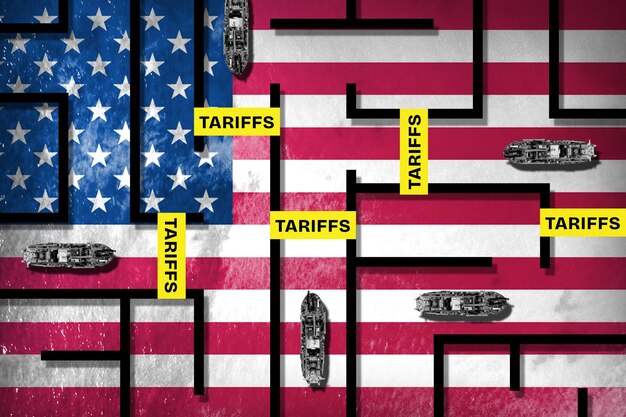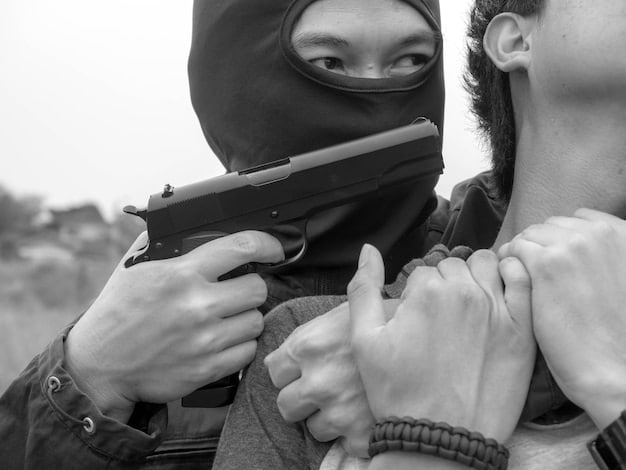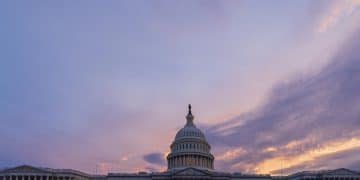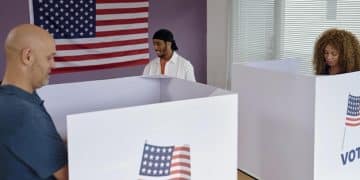Gun Control Debate: Proposed 2025 Laws & Crime Rate Impact

The debate over gun control in the US intensifies as proposed new laws aim to curb gun violence, sparking discussions about their potential impact on crime rates by 2025 and the Second Amendment.
The **debate over gun control: What are the Proposed New Laws and Their Potential Impact on Crime Rates in 2025?** remains one of the most contentious issues in the United States, igniting passions and dividing opinions across the political spectrum. Understanding the proposed changes and their projected effects is crucial for every informed citizen.
Understanding the Current Landscape of Gun Control Laws in the US
Gun control laws in the United States are a complex patchwork of federal, state, and local regulations. These laws dictate who can own firearms, the types of firearms that are permitted, and how they must be stored and used.
Federal Regulations on Firearms
At the federal level, the National Firearms Act (NFA) of 1934 and the Gun Control Act (GCA) of 1968 are the primary laws governing firearms. These acts regulate the sale, possession, and transfer of certain firearms, including machine guns, short-barreled rifles, and silencers.
State-Level Variations in Gun Control
State laws vary widely. Some states have strict regulations, including universal background checks, bans on assault weapons, and red flag laws. Other states have more lenient laws, with minimal restrictions on gun ownership and open carry provisions.

Here’s a list highlighting key differences in state-level gun control laws:
- Background Checks: Some states require universal background checks for all gun sales, while others only require them for sales by licensed dealers.
- Assault Weapons Bans: Several states have banned assault weapons and high-capacity magazines, while others do not have such restrictions.
- Red Flag Laws: Red flag laws allow law enforcement or family members to petition a court to temporarily remove firearms from individuals deemed a danger to themselves or others.
- Concealed Carry Permits: States vary in their requirements for obtaining a concealed carry permit, with some states having “permitless carry” laws.
The current legal landscape reflects a continuous tug-of-war between advocates for stricter gun control and those who defend Second Amendment rights. Understanding this landscape is crucial for evaluating proposed changes and their potential impact.
Proposed New Gun Control Laws for 2025
In response to persistent gun violence, several new gun control measures have been proposed at both the federal and state levels. These proposals aim to close existing loopholes, enhance background checks, and restrict access to certain types of firearms.
Federal Proposals Under Consideration
At the federal level, some of the proposed laws include expanding background checks to cover all gun sales, including those at gun shows and online. There are also proposals to ban assault weapons and high-capacity magazines, as well as to strengthen red flag laws.
State-Level Initiatives and Legislation
Several states are also considering stricter gun control measures. These include:
- Universal Background Checks: Expanding background checks to all gun sales.
- Increased Age Restrictions: Raising the minimum age to purchase firearms.
- Waiting Periods: Implementing waiting periods for gun purchases.
- Safe Storage Laws: Requiring gun owners to store firearms securely to prevent unauthorized access.

These proposed laws represent a significant shift towards stricter gun control, but they also face strong opposition from gun rights advocates who argue that they infringe on Second Amendment rights.
Potential Impact on Crime Rates: Projections for 2025
Predicting the precise impact of new gun control laws on crime rates is a complex undertaking, as many factors influence crime trends. However, several studies and analyses have attempted to project the potential effects of these laws.
Studies on the Effects of Gun Control Measures
Research on the impact of gun control laws on crime rates is mixed. Some studies suggest that stricter gun control measures can lead to a reduction in gun violence, while others find little or no effect. The specific impact often depends on the type of law and the context in which it is implemented.
Projected Crime Rate Changes in Specific Scenarios
Here are some potential scenarios and projected crime rate changes:
- Universal Background Checks: May reduce gun violence by preventing prohibited individuals from acquiring firearms.
- Assault Weapons Bans: Could decrease the number of mass shootings, but the overall impact on gun violence may be limited.
- Red Flag Laws: Have the potential to prevent suicides and mass shootings by temporarily removing firearms from individuals in crisis.
It is important to note that these are projections and the actual impact may vary. The effectiveness of gun control laws often depends on how well they are enforced and the broader social and economic context.
Arguments For and Against Gun Control
The debate over gun control is fueled by deeply held beliefs about individual rights, public safety, and the role of government. Understanding the arguments on both sides is crucial for a comprehensive understanding of the issue.
Arguments in Favor of Stricter Gun Control
Proponents of stricter gun control argue that it is necessary to reduce gun violence and save lives. They point to the high rates of gun-related deaths and injuries in the United States compared to other developed countries.
Arguments Against Stricter Gun Control
Opponents of stricter gun control argue that it infringes on Second Amendment rights and would not be effective in preventing crime. They argue that law-abiding citizens should have the right to own firearms for self-defense.
Here are some common arguments against stricter gun control:
- Second Amendment Rights: The right to bear arms is a fundamental right that should not be infringed.
- Self-Defense: Firearms are necessary for self-defense against criminals.
- Ineffectiveness: Gun control laws do not deter criminals, who will always find ways to obtain firearms.
The arguments for and against gun control reflect fundamental differences in values and beliefs about the role of firearms in society.
The Second Amendment and Gun Control Legislation
The Second Amendment to the United States Constitution guarantees the right of the people to keep and bear arms. However, the interpretation of this amendment has been the subject of ongoing debate, particularly in relation to gun control legislation.
Historical Interpretation of the Second Amendment
Historically, the Supreme Court has interpreted the Second Amendment in different ways. In the landmark case of District of Columbia v. Heller (2008), the Court affirmed that the Second Amendment protects an individual’s right to possess firearms for traditionally lawful purposes, such as self-defense in the home.
The Second Amendment in Modern Debates
In modern debates, the Second Amendment is often invoked by opponents of gun control legislation. They argue that any restrictions on firearms ownership are a violation of this fundamental right.
Key points in the Second Amendment debate include:
- Individual vs. Collective Right: Whether the Second Amendment protects an individual right or a collective right to bear arms as part of a well-regulated militia.
- Scope of the Right: The extent to which the right to bear arms is limited or unrestricted.
- Reasonable Restrictions: Whether certain gun control measures, such as background checks and bans on assault weapons, are reasonable restrictions on the right to bear arms.
The interpretation of the Second Amendment continues to shape the debate over gun control legislation in the United States.
Political and Social Factors Influencing Gun Control Policies
Gun control policies are influenced by a complex interplay of political and social factors. These factors include public opinion, lobbying efforts, political polarization, and cultural attitudes towards firearms.
The Role of Public Opinion
Public opinion on gun control is divided, with significant differences based on demographics, political affiliation, and geographic location. Changes in public opinion can influence the political feasibility of gun control legislation.
Lobbying Efforts by Interest Groups
Lobbying efforts by interest groups, such as the National Rifle Association (NRA) and gun control advocacy organizations, play a significant role in shaping gun control policies. These groups spend millions of dollars each year to influence lawmakers and public opinion.
Political and social influences on gun control policies include:
- Political Polarization: The increasing polarization of American politics has made it more difficult to pass gun control legislation at the federal level.
- Cultural Attitudes: Cultural attitudes towards firearms vary widely across the United States, influencing support for or opposition to gun control.
- Media Coverage: Media coverage of mass shootings and gun violence can influence public opinion and political pressure for gun control measures.
Understanding these political and social factors is essential for understanding the dynamics of the gun control debate and the prospects for future legislation.
| Key Point | Brief Description |
|---|---|
| 🛡️ Second Amendment | Guarantees the right to bear arms, but its interpretation is debated. |
| ⚖️ Proposed Laws | Include universal background checks and assault weapon bans. |
| 📉 Impact on Crime | Expected to potentially reduce gun violence, though effects are uncertain. |
| 📢 Public Opinion | Divided, influencing political feasibility of new laws. |
Gun Control: FAQs
▼
The Second Amendment protects the individual right to keep and bear arms. However, the scope of this right is often debated in the context of gun control.
▼
Red flag laws allow temporary removal of firearms from individuals deemed a danger to themselves or others, aiming to prevent tragedies.
▼
Background checks use the National Instant Criminal Background Check System (NICS) to prevent firearm sales to prohibited individuals.
▼
Assault weapons bans prohibit the sale of certain semi-automatic firearms and high-capacity magazines to reduce potential for mass shootings.
▼
The impact of gun control laws on crime rates is complex; some studies suggest reductions in gun violence, but results vary based on context.
Conclusion
The debate over gun control in the US is multifaceted, involving legal, ethical, and social considerations. As new laws are proposed and implemented, their impact on crime rates and individual liberties will continue to be a subject of intense scrutiny and discussion.





